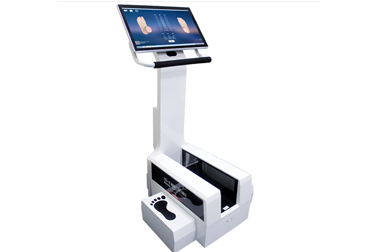Flatfoot measuring instrument – foot scanner for high-precision evaluation of flat feet and high arches
I. Principle of core evaluation technology
Non-contact 3D scanning technology
Using laser or optical scanning technology, full-dimensional foot data collection can be completed within 5-20 seconds without physical contact, including key parameters such as arch height, heel inversion and inversion angle, with a measurement accuracy of 0.5mm.
Example: 3D structured light scanning can generate a 1:1 real foot model and support millimeter-level foot size analysis (such as foot length, foot width, arch curvature).
II. Core advantages of high-precision evaluation
Break through the limitations of traditional detection
Compared with manual visual inspection or footprint method, 3D scanning can eliminate subjective judgment errors, such as accurately distinguishing physiological flat feet from pathological arch collapse.
Supports 128 data modeling of the foot, including scoliosis, high and low shoulders and other posture correlation analysis, to achieve whole-body biomechanical evaluation.
Data visualization and intelligent diagnosis
After scanning, a 3D foot model and a graphical report are automatically generated, which intuitively displays parameters such as the arch index (such as Feiss line classification) and heel eversion angle.
The built-in AI algorithm can intelligently match the foot health risk level, such as predicting the probability of plantar fasciitis in patients with high arches.

III. Practical application scenarios
Medical diagnosis and corrective intervention
When customizing orthopedic insoles for flatfoot patients, the weak support area is located through scanning data, and gradient density materials are used to achieve pressure redistribution. Clinical verification shows that the correction efficiency is increased by 35%.
During postoperative rehabilitation tracking, regular scanning is performed to monitor the progress of arch recovery and dynamically adjust the insole support strength.
Sports health management
Athletes use foot scans to identify the problem of insufficient cushioning caused by high arches, customize layered cushioning insoles, and reduce the risk of stress fractures.
Combined with gait analysis to optimize running posture, such as adjusting the heel landing angle to reduce the Achilles tendon load.
Consumer-grade shoe customization
Shoe companies use scanning data to achieve “foot inspection and shoe matching”, for example, designing sports shoes with thickened forefoot cushioning layers for users with high arches, and the repurchase rate is increased by 60% compared with standardized products .
